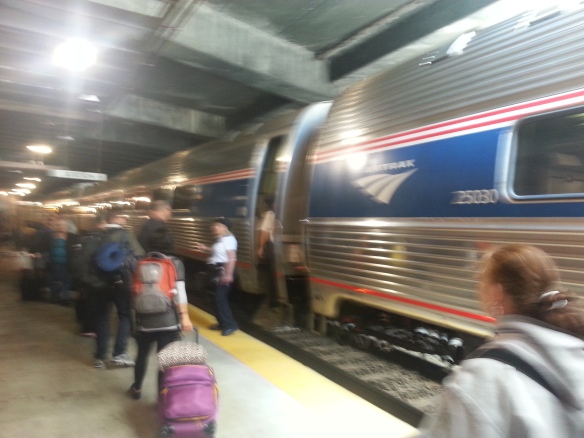Today, a major holiday blockbuster makes its debut on screens worldwide. One which my wife won tickets to an advanced screening of at the Regal Cinemas Fenway Stadium 13. Though I highly implore you to see said movie, being a transit blog and not a random pop culture/politics blog, I’ll point out that this gave me a reason to visit Fenway, the station which sits right to the south of its host building, Landmark Center.
The first outdoor station on the D branch heading outbound, Fenway sits on the edge of the Emerald Necklace, not far from the Back Bay Fens (though the stations of the E branch are actually closer), with Park Drive above the station leaving part of the station covered by its overpass. Getting off at Fenway, however, the scenery is dominated by nearby Fenway Park which sits about a third of a mile away, the Citgo sign over Kenmore Square in clear sight and some “Take the (T) to Fenway” Red Sox signs on the rock walls on the outbound platform. In the recent past, Fenway saw a lot of usage by Sox fans on game days though the institution of fares on the outbound Green Line and Kenmore becoming wheelchair accessible has reduced ridership at Fenway. The other dominating feature is that of Landmark Center, a former Sears catalog center now converted to a collection of big-box shops more common to the suburbs.
Getting off, we found that the signage to both Landmark Center and to Fenway Park are quite clear; the former literally is one at-grade crossing from the inbound platform, the latter has a small path which works its way to Brookline Avenue that is paved and well-lit. Interestingly, the signage to get to Landmark Center is much clearer than the signage inside Landmark Center itself as going in we ended up in a multi-floor maze to get to the cinemas. As we had to wait in line for what turned into an hour wait, I didn’t get to explore the area much though with St. Mary’s Street on the C and Museum of Fine Arts on the E not far away, there isn’t much that can be called solely the domain of Fenway station. Still, it’s a decent station and is unique amongst its D/Highland Branch siblings and is a visit if anything to knock it off your list.
Station: Fenway
Rating (1-10): 7
Ridership: At the start of evening rush, a mix of Landmark Center patrons and local residents getting off and those who work in the area from points west getting on. Landmark Center has a large amount of office space, much of it health-oriented, and nearby are Beth Isreael Deaconess Medical Center, three colleges (Emannuel, Simmons, and Wheelock), and with a walk down Fenway a quieter way to the museums along and near Huntington Avenue.
Pros: The fact the station is under a overpass and has rock walls adds a unique flavor and the fact that it serves as a more tranquil alternate to Kenmore and Museum of Fine Arts is a plus. Also, as with Northeastern some operators will open all doors outbound given the number of passengers getting off which is convenient to a degree.
Cons: Stations like Fenway, heck the D as a whole, show why front door-only boarding is onerous. Can’t we try to at least get some doorside CharlieCard readers (such as the buses on the Ottawa Transitway which use similar fareboxes and smart cards as the MBTA) and people with hand-held validators to have a compromise between proof of payment outdoors and faregates underground/Riverside/Science Park/Lechmere? As for Fenway itself, not much though its name has confused many through the years, my wife thought that the station was open only around Red Sox games and many a tourist has gotten off here rather than Kenmore.
Nearby and Noteworthy: Landmark Center itself has trappings suited more for suburbia ranging from Bed Bath and Beyond to REI to Longhorn Steakhouse among others and down the road will be gaining a Wegmans among others. The Emerald Necklace isn’t bad either as is that nearly 102 year old ballpark down Brookline Avenue.

